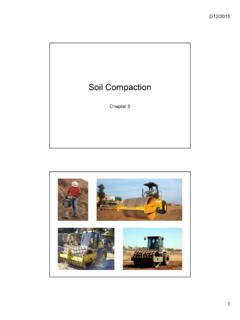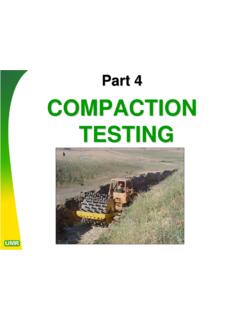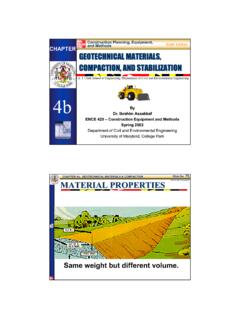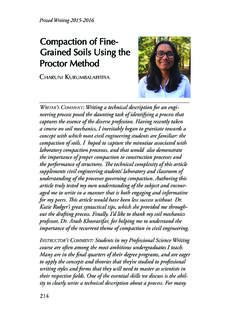Transcription of Standard Test Methods for Laboratory Compaction ...
1 Designation: D698 12 1 Standard Test Methods forLaboratory Compaction characteristics of soil UsingStandard Effort (12 400 ft-lbf/ft3(600 kN-m/m3))1 This Standard is issued under the fixed designation D698; the number immediately following the designation indicates the year oforiginal adoption or, in the case of revision, the year of last revision. A number in parentheses indicates the year of last reapproval. Asuperscript epsilon ( ) indicates an editorial change since the last revision or Standard has been approved for use by agencies of the Department of Defense. 1 NOTE Editorial corrections made throughout in January Scope* These test Methods cover Laboratory Compaction meth-ods used to determine the relationship between molding watercontent and dry unit weight of soils ( Compaction curve)compacted ina4or6-in. ( or ) diameter moldwith a ( ) rammer dropped from a height of (305 mm) producing a compactive effort of 12 400 ft-lbf/ft3(600 kN-m/m3).
2 NOTE1 The equipment and procedures are similar as those proposedby R. R. proctor (Engineering News Record September 7, 1933) withthis one major exception: his rammer blows were applied as 12 inch firmstrokes instead of free fall, producing variable compactive effort depend-ing on the operator, but probably in the range 15 000 to 25 000ft-lbf/ft3(700 to 1200 kN-m/m3). The Standard effort test ( )issometimes referred to as the proctor Soils and soil -aggregate mixtures are to be regarded asnatural occurring fine- or coarse-grained soils, or composites ormixtures of natural soils, or mixtures of natural and processedsoils or aggregates such as gravel or crushed rock. Hereafterreferred to as either soil or These test Methods apply only to soils (materials) thathave 30 % or less by mass of particles retained on the3 4-in.( ) sieve and have not been previously compacted inthe Laboratory ; that is, do not reuse compacted For relationships between unit weights and moldingwater contents of soils with 30 % or less by mass of materialretained on the3 4-in.
3 ( ) sieve to unit weights andmolding water contents of the fraction passing3 4-in. ( ) sieve, see Three alternative Methods are provided. The methodused shall be as indicated in the specification for the materialbeing tested. If no method is specified, the choice should bebased on the material 4-in. ( ) Passing No. 4 ( ) per Layer May be used if 25 % or less ( )bymass of the material is retained on the No. 4 ( ) Usage If this gradation requirement cannotbe met, then Method C may be 4-in. ( ) Passing3 8-in. ( ) per Layer May be used if 25 % or less ( )bymass of the material is retained on the3 8-in. ( ) Usage If this gradation requirement cannotbe met, then Method C may be 6-in. ( ) Passing3 4-in. ( ) per Layer May be used if 30 % or less ( )bymass of the material is retained on the3 4-in. ( ) The 6-in. ( ) diameter mold shall not be usedwith Method A or Results have been found to vary slightly when a material istested at the same compactive effort in different size molds, with thesmaller mold size typically yielding larger values of density/unit weight(1, pp.)
4 21+). If the test specimen contains more than 5 % by mass ofoversize fraction (coarse fraction) and the material will not beincluded in the test, corrections must be made to the unit massand molding water content of the specimen or to the appropri-ate field-in-place density test specimen using Test Methods are under the jurisdiction of ASTM CommitteeD18onSoil and Rock and are the direct responsibility of Texture,Plasticity and Density characteristics of edition approved May 1, 2012. Published June 2012. Originallyapproved in 1942. Last previous edition approved in 2000 as D698 07 1. boldface numbers in parentheses refer to the list of references at the end ofthis Standard .*A Summary of Changes section appears at the end of this standardCopyright ASTM International, 100 Barr Harbor Drive, PO Box C700, West Conshohocken, PA 19428-2959. United States1 Copyright by ASTM Int'l (all rights reserved); Fri Mar 28 10:05:10 EDT 2014 Downloaded/printed byJerry Sayson (Terra Testing Inc) pursuant to License Agreement.
5 No further reproductions This test method will generally produce a well-definedmaximum dry unit weight for non-free draining soils. If thistest method is used for free-draining soils the maximum unitweight may not be well defined, and can be less than obtainedusing Test All observed and calculated values shall conform to theguidelines for significant digits and rounding established inPracticeD6026, unless superseded by this For purposes of comparing measured or calculatedvalue(s) with specified limits, the measured or calculatedvalue(s) shall be rounded to the nearest decimal or significantdigits in the specified The procedures used to specify how data are collected/recorded or calculated, in this Standard are regarded as theindustry Standard . In addition, they are representative of thesignificant digits that generally should be retained. The proce-dures used do not consider material variation, purpose forobtaining the data, special purpose studies, or any consider-ations for the user s objectives; and it is common practice toincrease or reduce significant digits of reported data to becommensurate with these considerations.
6 It is beyond the scopeof this Standard to consider significant digits used in analyticalmethods for engineering The values in inch-pound units are to be regarded as thestandard. The values stated in SI units are provided forinformation only, except for units of mass. The units for massare given in SI units only, g or It is common practice in the engineering profession toconcurrently use pounds to represent both a unit of mass (lbm)and a force (lbf). This implicitly combines two separatesystems of units; that is, the absolute system and the gravita-tional system. It is scientifically undesirable to combine the useof two separate sets of inch-pound units within a singlestandard. This Standard has been written using the gravitationalsystem of units when dealing with the inch-pound system. Inthis system, the pound (lbf) represents a unit of force (weight).However, the use of balances or scales recording pounds ofmass (lbm) or the recording of density in lbm/ft3shall not beregarded as a nonconformance with this Standard does not purport to address all of thesafety concerns, if any, associated with its use.
7 It is theresponsibility of the user of this Standard to establish appro-priate safety and health practices and determine the applica-bility of regulatory limitations prior to Referenced standards :3C127 Test Method for Density, Relative Density (SpecificGravity), and Absorption of Coarse AggregateC136 Test Method for Sieve Analysis of Fine and CoarseAggregatesD653 Terminology Relating to soil , Rock, and ContainedFluidsD854 Test Methods for Specific Gravity of soil Solids byWater PycnometerD2168 Practices for Calibration of Laboratory Mechanical-Rammer soil CompactorsD2216 Test Methods for Laboratory Determination of Water(Moisture) Content of soil and Rock by MassD2487 Practice for Classification of Soils for EngineeringPurposes (Unified soil Classification System)D2488 Practice for Description and Identification of Soils(Visual-Manual Procedure)D3740 Practice for Minimum Requirements for AgenciesEngaged in Testing and/or Inspection of soil and Rock asUsed in Engineering Design and ConstructionD4253 Test Methods for Maximum Index Density and UnitWeight of Soils Using a Vibratory TableD4718 Practice for Correction of Unit Weight and WaterContent for Soils Containing Oversize ParticlesD4753 Guide for Evaluating, Selecting, and Specifying Bal-ances and Standard Masses for Use in soil , Rock, andConstruction Materials TestingD4914 Test Methods for Density and Unit Weight of Soiland Rock in Place by the Sand Replacement Method in aTest PitD5030 Test Method for Density of soil and Rock in Place bythe Water Replacement Method in a Test PitD6026 Practice for Using Significant Digits in GeotechnicalDataD6913 Test Methods for Particle-Size Distribution (Grada-tion)
8 Of Soils Using Sieve AnalysisE11 Specification for Woven Wire Test Sieve Cloth and TestSievesE177 Practice for Use of the Terms Precision and Bias inASTM Test MethodsE691 Practice for Conducting an Interlaboratory Study toDetermine the Precision of a Test MethodIEEE/ASTM SI 10 Standard for Use of the InternationalSystem of Units (SI): the Modern Metric System3. See TerminologyD653for general water content, n the adjusted water contentof a soil (material) that will be effort in Compaction testing, the term forthe 12 400 ft-lbf/ft3(600 kN-m/m3) compactive effort appliedby the equipment and Methods of this maximum dry unit weight, d,maxin lbf/ft3(kN/m3) in Compaction testing, the maximum value de-fined by the Compaction curve for a Compaction test usingstandard optimum water content, woptin % in com-paction testing, the molding water content at which a soil canbe compacted to the maximum dry unit weight using standardcompactive of Terms Specific to This fraction (coarse fraction)
9 , PCin % the por-tion of total specimen not used in performing the compaction3 For referenced ASTM standards , visit the ASTM website, , orcontact ASTM Customer Service at ForAnnual Book of ASTMS tandardsvolume information, refer to the Standard s Document Summary page onthe ASTM 12 12 Copyright by ASTM Int'l (all rights reserved); Fri Mar 28 10:05:10 EDT 2014 Downloaded/printed byJerry Sayson (Terra Testing Inc) pursuant to License Agreement. No further reproductions ; it may be the portion of total specimen retained on the ( ) sieve in Method A,3 8-in. ( ) sieve inMethod B, or3 4-in. ( ) sieve in Method fraction (finer fraction), PFin % the portion ofthe total specimen used in performing the Compaction test; it isthe fraction passing the No. 4 ( ) sieve in Method A,passing the3 8-in. ( ) sieve in Method B, or passing the3 4-in. ( ) sieve in Method Summary of Test A soil at a selected molding water content is placed inthree layers into a mold of given dimensions, with each layercompacted by 25 or 56 blows of a ( ) rammerdropped from a distance of in.
10 ( mm), subjectingthe soil to a total compactive effort of about 12 400 ft-lbf/ft3(600 kN-m/m3). The resulting dry unit weight is deter-mined. The procedure is repeated for a sufficient number ofmolding water contents to establish a relationship between thedry unit weight and the molding water content for the soil . Thisdata, when plotted, represents a curvilinear relationship knownas the Compaction curve. The values of optimum water contentand Standard maximum dry unit weight are determined fromthe Compaction Significance and soil placed as engineering fill (embankments, founda-tion pads, road bases) is compacted to a dense state to obtainsatisfactory engineering properties such as, shear strength,compressibility, or permeability. In addition, foundation soilsare often compacted to improve their engineering Compaction tests provide the basis for determiningthe percent Compaction and molding water content needed toachieve the required engineering properties, and for controllingconstruction to assure that the required Compaction and watercontents are During design of an engineered fill, shear, consolidation,permeability, or other tests require preparation of test speci-mens by compacting at some molding water content to someunit weight.










